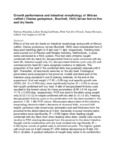| dc.description.abstract | Effects of live and dry feeds on intestinal morphology and growth of African
catfish, Clarias gariepinus, larvae (Burchell, 1822) were investigated from 2
days post hatching (dph) to 6 dph and 11 dph, respectively. Feeding trials
were carried out at Fleuren and Nooijen hatchery, Netherlands, in glass
tanks connected to a RAS system. Five test diets (Artemia nauplii
combined with dry feed (A), decapsulated Artemia cysts combined with dry
feed (B), Artemia nauplii only (C), decapsulated Artemia cysts only (D) and
commercial dry feed (E)) were assigned randomly in triplicate. The
proportion of live feed in the combined diets was gradually reduced until 6
dph. Thereafter, all treatments were fed on the dry feed. Histological
parameters were analysed in the proximal, middle and distal part of the
intestine using standard H and E staining methods. At the end of the
experiment, final wet weight (17.90 ± 0.38 mg) and specific growth rate
(SGR) (24.12 ± 0.35%/day) were significantly higher (P < 0.05) in larvae
fed nauplii combined with dry feed. A diet of decapsulated Artemia cysts
resulted in the lowest values for these parameters (8.90 ± 0.44 mg and
17.18 ± 0.28%/day, respectively). FCR was best in the diets using nauplii
only (0.53 ± 0.12) or nauplii combined with dry diet (0.70 ± 0.30). Feeding
decapsulated Artemia cysts or its combination with dry feed resulted in the
poorest (1.62–1.66) FCR values. Microscopic observation of the intestinal
morphology demonstrated a decrease of mucosal folds, mucosal fold
height, perimeter ratio (inner/outer perimeter) and wall thickness from the
proximal to the distal intestine at 6 dph. Generally mucosal morphometric
parameters were significantly (P < 0.05) higher when feeding nauplii
combined with dry feed, than when feeding other diets. Goblet cells counts
relative to PAS staining decreased from the proximal to the distal intestine.
Nauplii and its combination with dry feed resulted into significantly (P <
0.05) higher counts of goblet cells in all intestinal parts. The highest goblet
cell count was on 4 dph (range 57–254) before decreasing by 6 dph (32–
54) in all diets. A gradual reduction of nauplii daily ration in its combination with dry feed stimulated morphological development that resulted in
improved growth performance. Different starter feeds thus had an impact
on intestinal morphological development and on growth in the larval phase,
but could also affect further rearing results. | en_US |

